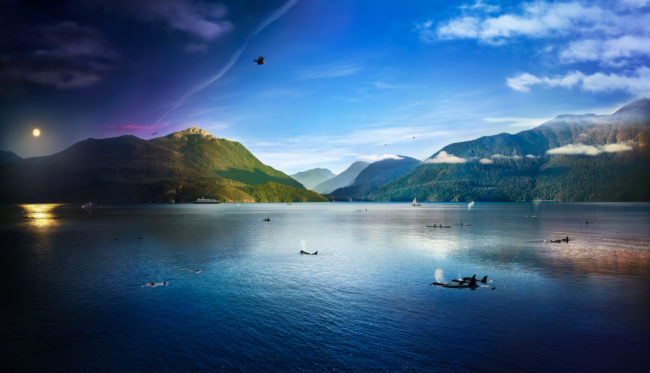The Art of the Personal Project is a crucial element to let potential buyers see how you think creatively on your own. I am drawn to personal projects that have an interesting vision or that show something I have never seen before. In this new revised thread, I’ll include a link to each personal project with the artist statement so you can see more of the project. Please note: This thread is not affiliated with any company; I’m just featuring projects that I find. Please DO NOT send me your work. I do not take submissions.
Today’s featured artist: Stephen Wilkes
Transcend the Passage of Time in ‘Day to Night: In the Field with Stephen Wilkes,’ Opening at National Geographic Museum Feb. 13 Exhibition features captivating images of spectacular bird migrations across the globe taken by iconic photographer Stephen Wilkes
WASHINGTON ( Jan. 16 , 201 7 )— For 130 years, National Geographic has been using the power of photography to tell meaningful stories, inspire people to take action and transport audiences to unseen places. A new exhibition opening at the National Geographic Museum on Feb. 13, ‘Day to Night: In the Field with Stephen Wilkes,’ takes that experience even further by showcasing stunning images by iconic photographer Stephen Wilkes that capture the passage of time. The exhibition will be on display at the National Geographic Museum through April 30, 2018.
Wilkes, a New York–based photographer who is widely recognized for his fine art and commercial work, creates visually compelling scenes expertly crafted from more than 1,500 images taken from a fixed vantage point over the course of fifteen to thirty hours, from sunrise to sunset. Wilkes spent much of 2017 in the field on assignment documenting bird migration routes for the March 2018 issue of National Geographic magazine.
In ‘Day to Night,’ visitors can marvel at Wilkes’ stunning compositions of landscapes paired with human or animal narratives and appreciate the movement and energy of locations such as Serengeti National Park and Brooklyn Bridge Park in New York City as they transition from day to night. The exhibition gives visitors behind-the-scenes insight into all that’s involved in Wilkes’ shoots, from the research put into scouting locations; to determining how time will move through the image, either horizontally, vertically, or diagonally; to the time spent conducting the actual shoot; and finally to the extensive editing process, during which Wilkes selects the best moments captured from thousands of images to seamlessly combine them into the stunning finished product.
Time and memory, the essence of why we photograph. Photography has historically been defined as a single moment, captured in time. Our memories are defined by these moments, illuminating our consciousness of time as we age.
Years ago, I imagined changing time within a single photograph; compressing the best moments of a day and night into a single image. Photographic technology has now evolved to allow my dreams to now become reality.
Most impressively, the exhibition features four expansive and powerful mega-prints of captivating bird migrations, measuring roughly 7 feet tall and 12 feet wide, that reflect the theme of conservation. Behind the scenes of each massive image, visitors will learn about the species, the location where Wilkes photographed them and what makes them integral to the ecosystem. Visitors to the exhibition will have an intimate look at these species:
- Black-browed albatrosses in the Falkland Islands, sitting on their nests, warming and protecting their chicks, while their partners soar above them hunting for prey;
- Northern gannets on Bass Rock, off the coast of Scotland, that flocked to the island during breeding season only to migrate as far as West Africa in the winter;
- Sandhill cranes on Nebraska’s Platte River, huge birds that spend their days fattening up on waste grain left in the fields to prepare for their migration to sub-Arctic and Arctic nesting grounds;
- and Lesser flamingos at Lake Bogoria, Kenya, that thrive in the extreme environment of high-altitude soda lakes, feeding on algal blooms that are toxic to many other creatures. Behind the prints, visitors can also read fascinating stories detailing the lengths to which Wilkes went to get the perfect shot, from surviving dive-bomb attacks from birds above to being trapped in a bird blind for 36 hours. The mega-print gallery in the exhibition focuses on migratory species and their habitats that are under threat due to climate change and human impact, such as commercial fishing and menacing tourists. Wilkes’ photography can be used as an instrument for change, inspiring solutions to help protect species and habitats that are at risk. His impressive field work documenting these beautiful species was supported by a storytelling grant from the National Geographic Society. “We have marvelled at Stephen’s iconic Day to Night images for a long time and wondered how his unique imaging technique might be used to illustrate the power of an ecosystem or the magic and mysteries of bird migrations,” said National Geographic Museum Director Kathryn Keane. “This exhibition reveals the results of his year in the field—and they are simply stunning.”
The exhibition ties in to National Geographic’s year-long initiative to highlight bird species and their migration patterns, aptly titled the Year of the Bird . The Year of the Bird is a partnership between National Geographic, the Audubon Society, Cornell Lab of Ornithology, BirdLife International and over 100 other organizations. Through 12 months of storytelling, science research and conservation efforts, the Year of the Bird will examine how our changing environment is driving dramatic losses among bird species around the globe and highlight what we can do to help protect them. Wilkes’ stunning images documenting the four ancient bird migration routes across the globe can be found in the March 2018 issue of National Geographic magazine.
The National Geographic Museum, 1145 17th Street, N.W., Washington, D.C., is open every day (except Thanksgiving and Christmas) from 10 a.m. to 6 p.m.
Public Events:
Wilkes will give a behind-the-scenes look at his work during a talk on Tuesday, Feb. 13, 2018, at 7:30 p.m. and the exhibition will remain open until 7:15 p.m. on this date. Tickets are $25. For more information, please see here. In a special Student Matinee, students in grades 5-8 will join Wilkes on his most recent National Geographic assignments photographing the elegant and mysterious patterns of bird migrations across landscapes in Kenya, Scotland, the Falkland Islands, and the Platte River in Nebraska. For more information on National Geographic’s student matinees, please see here .
About Stephen Wilkes
Photographer STEPHEN WILKES’s widely recognized work ranges from capturing the long-abandoned medical wards on Ellis Island and the impacts of Hurricane Katrina to shooting advertising campaigns for the world’s leading corporations. His photographs are included in public and private collections globally, and his editorial work has appeared in National Geographic , The New York Times Magazine , Vanity Fair , and many others. His highly acclaimed first monograph, Ellis Island: Ghosts of Freedom , was published in 2006, and his second, featuring his iconic Day to Night series, will be published by Taschen in 2018. Stephen has shot advertising campaigns for Netflix, Capital One, the New Yorker , Rolex, and many others. His extensive awards and honors include the Alfred Eisenstaedt Award for Magazine Photography, Photographer of the Year from Adweek magazine, and the Fine Art Photographer of the Year Lucie Award.
About the National Geographic Society
The National Geographic Society is a leading nonprofit that invests in bold people and transformative ideas in the fields of exploration, scientific research, storytelling and education. Through our grants and programs, we aspire to create a community of change, advancing key insights about our planet and probing some of the most pressing scientific questions of our time while ensuring that the next generation is armed with geographic knowledge and global understanding. Our goal is measurable impact: furthering exploration and educating people around the world to inspire solutions for the greater good. For more information, visit www.nationalgeographic.org.




To see more of this project, click here. and here
APE contributor Suzanne Sease currently works as a consultant for photographers and illustrators around the world. She has been involved in the photography and illustration industry since the mid 80s. After establishing the art buying department at The Martin Agency, then working for Kaplan-Thaler, Capital One, Best Buy and numerous smaller agencies and companies, she decided to be a consultant in 1999. She has a new Twitter feed with helpful marketing information because she believes that marketing should be driven by brand and not by specialty. Follow her at @SuzanneSease.
1 Comment
[…] • The art of the personal project with Stephen Wilkes. […]
Comments are closed for this article!